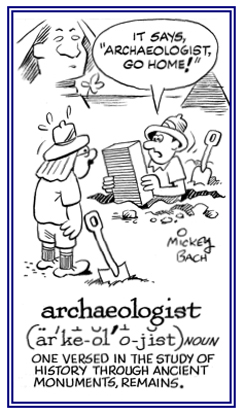archaeo-, archeo-, archae-, arche-, archa-, archi-, -arch
(Greek: original [first in time], beginning, first cause, origin, ancient, primitive, from the beginning; most basic)
arched (s) (adjective), more arched, most arched
1. Referring to something that is formed in a curve; curved: When in the old church, Judy viewed many colourfully arched windows.
2. Provided, made, or covered with an arch: The old bridge in the town was built in an arched manner so as to afford good stability.
2. Provided, made, or covered with an arch: The old bridge in the town was built in an arched manner so as to afford good stability.
The name given to a hypothetical scheme of wing venation proposed for the very first winged insect: Archedictyon is based on a combination of speculation and fossil data. Since all winged insects are believed to have evolved from a common ancestor, the archedictyon represents the "template" that has been modified (and streamlined) by natural selection for 200 million years.
According to current dogma, the archedictyon contained 6-8 longitudinal veins.
The hypothesis that life can come into being from nonliving matter; archebiosis: Mary simply didn't believe that life forms could be created by the method of archegenesis, of that an organism could come into life spontaneously only from a stone or pebble, for example.
In botany, a multicellular, often flask-shaped, egg-producing organ: Archegonia can exist in mosses, ferns, and most gymnosperms.
Spontaneous generation; abiogenesis; autogenesis: In her book, Jane read about archegony being a hypothetical process in which a life form first appeared on earth from a substance that was inanimate or did not process life.
The part of the primitive embryonic brain from which the forebrain and midbrain develop: The archencephalon of the foetus includes the anterior part of the brain along with the cerebrum, thalamus, and hypothalamus.
A chief foe or someone's main or worst rival: In the medieval adventure story Greg was reading, the king and his knights were fighting the archenemy of their land.
For most people, the principle archenemy of their health is cancer.
The cavity inside an embryo at the gastrula stage: The archenteron is the central cavity of the gastrula, which ultimately becomes the intestinal or digestive cavity.
A branch of geology that studies the geological formations of the remote past: Archeogeology integrates some archaeological fields with relevant geological sciences to investigate the geological effects on historical sites, monuments, and other properties concerning constructive materials (type, situation, and position of mines and other natural resources) and destructive geological forces in the environment, such as earthquakes, faults, and earth movements.
Archeogeologies make use of geological maps that indicate prehistoric layers of the earth's crust, faults, hisoric and recently found mines, hydrology layers, and seismological information all of which provide basic information in this field.
A systematic description of antiquities or ancient items or situations: Mr. and Mrs. Dawson were both involved in archeography and preparing reports and treaties about historical times for publishing.
archeokinetic (adjective) (not comparable)
An outdated term denoting or relating to a primitive type of motor nerve mechanism: such as is found in the peripheral and the ganglionic nervous systems: The archeokinetic region in a person's body is found in the ganglionic and peripheral nervous systems.
A professional scholar who studies and reconstructs the human past through its physical remains: The work of an archaeologist involves the scientific finding, collecting, cleaning, sorting, identifying, and the measuring of objects found in or on the earth or sea.

© ALL rights are reserved.
Go to this Word A Day Revisited Index
Usually the motives of archeologists are to record and to interpret ancient cultures rather than to collect and to display artifacts for a profit.

Go to this Word A Day Revisited Index
so you can see more of Mickey Bach's cartoons.
Archeopithecus (proper noun)
An ancient and extinct genus of Notoungulate: Archeopithecus belongs to the suborder Typotheria, and the animal was relatively small, like a rodent and weighed less than two kilos.
Someone who shoots with a bow and arrow; bowman; marksman; Sam used to be an archer who had an expensive bow and excellent arrows and took part in competitions.
1. The art, sport, or skill of shooting with a bow and arrow (no pl): At high school, part of the physical educational program was archery.
2. The equipment of a bowman; bowmen collectively: All the archery that they had fit into the small car on their way to the competition.
2. The equipment of a bowman; bowmen collectively: All the archery that they had fit into the small car on their way to the competition.
Related "time" units: aevum, evum; Calendars; chrono-; horo-; pre-; Quotes: Time; tempo-.


